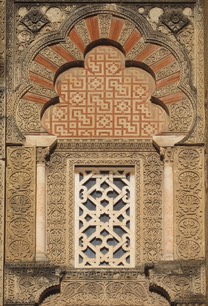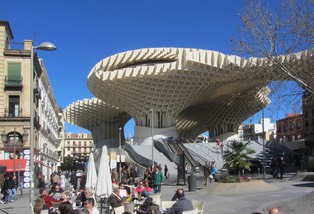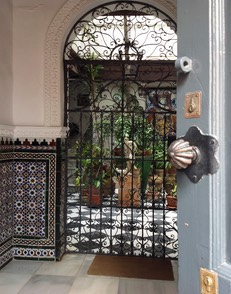
European cities display rich, diverse and overlapping historical influences through their architecture. Over centuries Etruscan, Phoenician, Greek, Egyptian, Carthaginian, Germanic, and Spanish traces all contributed towards the rising Roman Empire.
Declining Roman influence throughout Southern Spain saw Cordoba gain prominence in the early eighth century as the supreme centre of learning for exiled Moors from Damascus. Innovative irrigation and agriculture hugely expanded Andalusia's economy. Resultant rapid population growth justified building the world's largest Mosque in 712AD - Cordoba's Mezquita. This masterpiece has survived generations of 'interventions' and intrusions and remains an awe inspiring site.
Seville benefitted most from Moorish influence in Andalucia. The Royal Palaces (Reales Alcazares) reveal stages in the city's early development, and subsequent 'Golden Era' on becoming the Port for Atlantic sea-trade with America.
Oscillating fortunes for Muslim, Hebrew, and Christian populations are still evident, but often new temples obliterate predecessors as in converting a synagogue into the Church of Saint Bartholomew. Seville's magnificent Cathedral itself was built over a great mosque leaving only the moorish ablutions area, "Patio of the Orange Trees", and the Minaret. Originally used for call to prayers the tower, 'Giralda' gained height with Herman Ruiz's delicate renaissance belfry (1568) and remains Seville's main icon.

An incongruous contender by German architect and artist Jurgen Mayer Hermann appeared in 2011 and is now affectionately called 'incarnations mushrooms'. A curvy giant timber waffle 'Metropol Parasol' spans La Encarnacion square shading open markets, new performance spaces and simultaneously creating high panoramic terraces with restaurant to view Seville's predominantly ancient context.
Moorish motifs and decorative inscriptions, along with horseshoe arches, red and white keystones, saw-tooth and pointed variations give Seville an exotic appearance. In keeping with tradition, projects in the historic centre are still planned on enclosed sites along narrow streets with floor plates arranged around courtyards. Restricted facades limit windows and street presentation, and form inward facing apartments which gain light and ventilation through decorative screens within full height courtyards. This traditional moorish form is now acknowledged as Andalusian.

Formality outside studded timber doors yeilds to cool filigree mosaic reception halls with colourful tiled emblems and organic iron work, leading towards dynamic brightly light central patios. Decorative screens, fountains and plants soften these patios and provide shade from high sun while reinforcing privacy, individuality and intimacy within buildings.
In describing Architecture as "frozen music" Goethe could have been considering Andalucia. Like its architecture, the region's music and dance is rooted in East Indian and Arabic forms, modified and adapted by Christians, Jews, and gypsies. Persecution under Arab rule and later the Spanish inquisition, found expression through Flamenco in spirited protest and emotional anguish for these subjugated masses.
Flamenco's narrative (cante) can be profound and intense (Jondo), or (Chico) if lighter, and is accompanied and even overshadowed by hand-clapping with loud high energy improvised dance. Andalusian architecture similarly reveals proud poise and posture. It has real attitude, yet remains frilly and colourful with dynamic rhythm, and extensive fine decoration - possibly also improvised? - Perhaps 'Frozen Flamenco'?